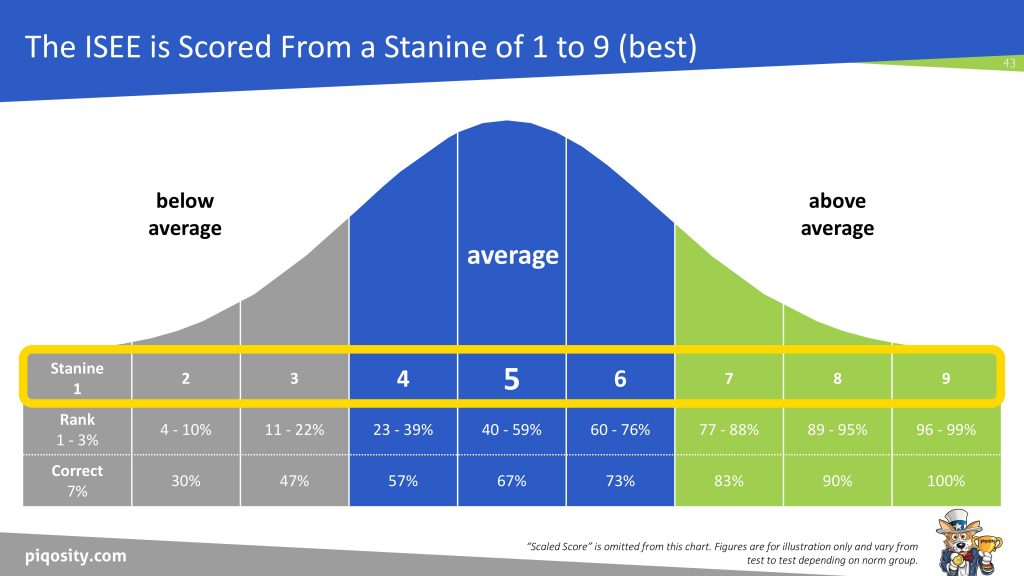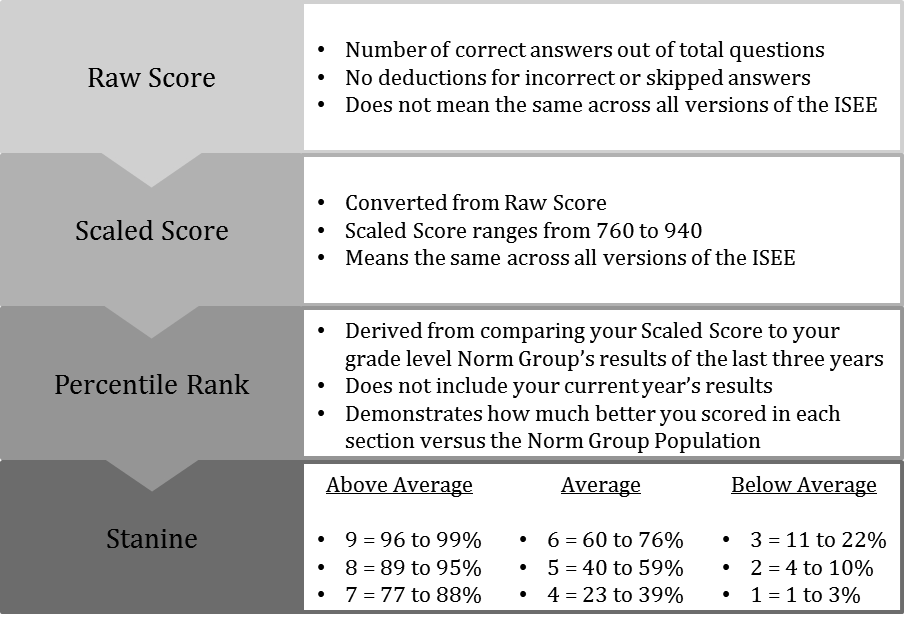Students taking the ISEE Upper Level will receive a “stanine score” that ranges from 0 to 9, with 9 being best. They will receive an overall stanine in addition to stanine scores for each sub-test (Verbal Reasoning, Quantitative Reasoning, Reading Comprehension, Mathematics Achievement.)
The stanine scores are what schools ostensibly care about most and what you’ll hear other parents discussing. However, each of the four sections on the ISEE will receive four (4) scores in total, which together provide a deep picture of your child’s performance:
- Raw Score
- Scaled Score
- Percentile Rank
- Stanine
The Raw Score is the number of questions you answered correctly. There are no deductions for incorrect answers on the ISEE, and no points are earned or deducted for skipped questions. Therefore, it is in your best interest to have an answer filled in for all questions on the ISEE. It is important to note that no matter how you fare on your ISEE, you cannot ultimately fail the test.
Like the SAT and ACT, there are many versions of the ISEE in circulation, which means that the version of the ISEE you take will be different from the version of the ISEE the student sitting next to you is taking. This also means that your Raw Score of 22 for your Verbal Reasoning section will be different from his Raw Score of 22. Thus, the ERB converts your Raw Score into a Scaled Score, ranging from 760 to 940. These Scaled Scores mean the same thing across all versions of the ISEE and are used to compare you against the Norm Group to determine your Percentile Rank and Stanine.
Norm Group – Last Three Years of Test Takers
Your Percentile Rank represents how well you did in comparison to the Norm Group, such as scoring a 50th Percentile Rank means you scored better than 50% of the Norm Group.
The Norm Group is all students at your grade level (ex. all 8th graders) who have taken the ISEE over the last three years. However, you will not be compared to those students who are in your grade for the year you take the ISEE.
In other words, you will not be compared to the student taking the test next to you.
ISEE Stanine Scores Explained
Essentially, your stanine score is an easy way to sum up your child’s statistical place on a bell curve. Short for “standard nine,” the stanine takes the entire Norm Group and plots their results along a Normal Curve/ bell curve (illustrated below).
Those results are further subdivided into nine intervals. Each bracket represents 0.5 standard deviation with the exception of the first and last brackets which are the remainders. Note from the graphic below that stanines of 4, 5, and 6 represent the bulk of the Norm Group or average performance while scores of 7, 8, and 9 represent exceptional scores.

Most schools accept average students; therefore, stanine scores of 4, 5, and 6 are good enough to ensure that your child receives thoughtful consideration. However, students applying to academically rigorous and elite schools should strive to score 7, 8, or 9.
But remember that ISEE scores are just one part of a complex application process, and every school has its own unique criteria for evaluating both family and student fit.
Good luck!
—
This How-To Guide is adapted from “Upper Level ISEE Prep Guide with 6 Full-Length Practice Tests, 3rd Edition” by Stephen Hayes and the Staff of General Academic. You can buy it on Amazon for about $50. You can also read more about the Upper Level ISEE in, “Overview and Test-Taking Strategies for the Upper Level ISEE.”




